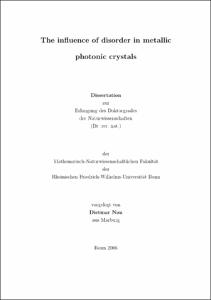Nau, Dietmar: The influence of disorder in metallic photonic crystals. - Bonn, 2006. - Dissertation, Rheinische Friedrich-Wilhelms-Universität Bonn.
Online-Ausgabe in bonndoc: https://nbn-resolving.org/urn:nbn:de:hbz:5N-07859
Online-Ausgabe in bonndoc: https://nbn-resolving.org/urn:nbn:de:hbz:5N-07859
@phdthesis{handle:20.500.11811/2625,
urn: https://nbn-resolving.org/urn:nbn:de:hbz:5N-07859,
author = {{Dietmar Nau}},
title = {The influence of disorder in metallic photonic crystals},
school = {Rheinische Friedrich-Wilhelms-Universität Bonn},
year = 2006,
note = {This thesis provides a comprehensive analysis of the influence of disorder on the optical properties of metallic photonic crystal slabs. These artificial crystals consist of metallic nanowires that are arranged on top of a dielectric waveguide material. Such structures belong to the class of active photonic crystals that exhibit simultaneously electronic and photonic resonances in the same spectral range. The structures show strong coupling effects with characteristic spectral transmission features and pronounced bandstructures. Both are dominated by the properties of a polariton-type quasiparticle. In this work, artificial disorder with a well-defined type and amount is introduced into these structures with high accuracy. When measuring the optical properties of these manipulated systems, a direct relation between disorder type and amount on the one hand and their spectral characteristics on the other hand is found. Thus, the structures presented in this thesis can serve as model system for structures with intrinsic disorder.
In the first part of the thesis, the disorder models are presented and characterized in detail. Different kinds of positional disorder are considered, where the positions of the nanowires on top of the waveguide slab are varied with respect to the perfect arrangement. The disorder models differ in the positions of next-neighbors that are either correlated or uncorrelated. Statistical methods, two-point correlation functions, and Fourier-analysis are utilized to reveal the differences of the models. Transmission experiments at normal light incidence show that disorder strongly influences the optical properties of the structures. The observed modified polariton coupling is explained in terms of a simple model, that is based on the reduced spatial overlap of the resonances in the disordered samples. Furthermore, the observed spectral effects are completely reproduced by a straightforward theory derived from diffraction theory. Angle-resolved measurements yield the bandstructure of the polaritonic system. It is shown how the bandstructure is influenced by disorder type and amount.
In the second part of the thesis, concepts for possible applications are discussed that are based on the perfect metallic photonic crystal slab. Covering the structure with a layer of a photoaddressable polymer allows to realize an all-optical switch. This device makes use of the optically induced birefringence in the polymer layer. The results are confirmed nicely by theoretical calculations. Using a hydrogen-gas sensitive material as waveguide layer allows to change the transmission spectrum of the sample in dependency of the hydrogen concentration in the surrounding. A change of the transmission as well as of the resonance-wavelengths in different hydrogen atmospheres is observed. Such modified samples can be employed as sensors for hydrogen gas.},
url = {https://hdl.handle.net/20.500.11811/2625}
}
urn: https://nbn-resolving.org/urn:nbn:de:hbz:5N-07859,
author = {{Dietmar Nau}},
title = {The influence of disorder in metallic photonic crystals},
school = {Rheinische Friedrich-Wilhelms-Universität Bonn},
year = 2006,
note = {This thesis provides a comprehensive analysis of the influence of disorder on the optical properties of metallic photonic crystal slabs. These artificial crystals consist of metallic nanowires that are arranged on top of a dielectric waveguide material. Such structures belong to the class of active photonic crystals that exhibit simultaneously electronic and photonic resonances in the same spectral range. The structures show strong coupling effects with characteristic spectral transmission features and pronounced bandstructures. Both are dominated by the properties of a polariton-type quasiparticle. In this work, artificial disorder with a well-defined type and amount is introduced into these structures with high accuracy. When measuring the optical properties of these manipulated systems, a direct relation between disorder type and amount on the one hand and their spectral characteristics on the other hand is found. Thus, the structures presented in this thesis can serve as model system for structures with intrinsic disorder.
In the first part of the thesis, the disorder models are presented and characterized in detail. Different kinds of positional disorder are considered, where the positions of the nanowires on top of the waveguide slab are varied with respect to the perfect arrangement. The disorder models differ in the positions of next-neighbors that are either correlated or uncorrelated. Statistical methods, two-point correlation functions, and Fourier-analysis are utilized to reveal the differences of the models. Transmission experiments at normal light incidence show that disorder strongly influences the optical properties of the structures. The observed modified polariton coupling is explained in terms of a simple model, that is based on the reduced spatial overlap of the resonances in the disordered samples. Furthermore, the observed spectral effects are completely reproduced by a straightforward theory derived from diffraction theory. Angle-resolved measurements yield the bandstructure of the polaritonic system. It is shown how the bandstructure is influenced by disorder type and amount.
In the second part of the thesis, concepts for possible applications are discussed that are based on the perfect metallic photonic crystal slab. Covering the structure with a layer of a photoaddressable polymer allows to realize an all-optical switch. This device makes use of the optically induced birefringence in the polymer layer. The results are confirmed nicely by theoretical calculations. Using a hydrogen-gas sensitive material as waveguide layer allows to change the transmission spectrum of the sample in dependency of the hydrogen concentration in the surrounding. A change of the transmission as well as of the resonance-wavelengths in different hydrogen atmospheres is observed. Such modified samples can be employed as sensors for hydrogen gas.},
url = {https://hdl.handle.net/20.500.11811/2625}
}






